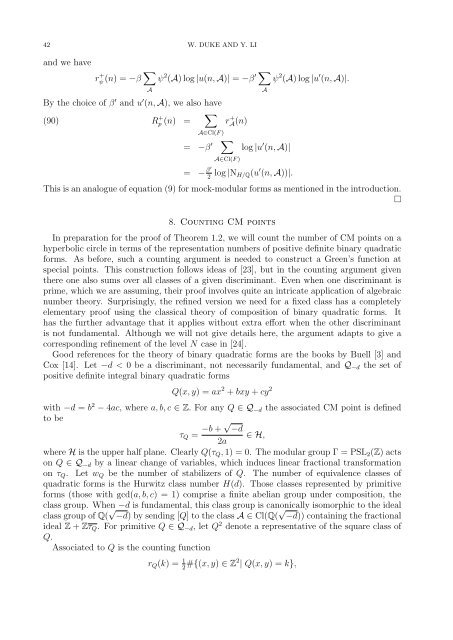Mock-modular forms of weight one - UCLA Department of Mathematics
Mock-modular forms of weight one - UCLA Department of Mathematics
Mock-modular forms of weight one - UCLA Department of Mathematics
Create successful ePaper yourself
Turn your PDF publications into a flip-book with our unique Google optimized e-Paper software.
42 W. DUKE AND Y. LI<br />
and we have<br />
r + ψ (n) = −β ∑ A<br />
ψ 2 (A) log |u(n, A)| = −β ′ ∑ A<br />
ψ 2 (A) log |u ′ (n, A)|.<br />
By the choice <strong>of</strong> β ′ and u ′ (n, A), we also have<br />
(90)<br />
∑<br />
R p + (n) = r + A (n)<br />
A∈Cl(F )<br />
∑<br />
= −β ′ log |u ′ (n, A)|<br />
A∈Cl(F )<br />
= − β′<br />
2 log |N H/Q(u ′ (n, A))|.<br />
This is an analogue <strong>of</strong> equation (9) for mock-<strong>modular</strong> <strong>forms</strong> as menti<strong>one</strong>d in the introduction.<br />
□<br />
8. Counting CM points<br />
In preparation for the pro<strong>of</strong> <strong>of</strong> Theorem 1.2, we will count the number <strong>of</strong> CM points on a<br />
hyperbolic circle in terms <strong>of</strong> the representation numbers <strong>of</strong> positive definite binary quadratic<br />
<strong>forms</strong>. As before, such a counting argument is needed to construct a Green’s function at<br />
special points. This construction follows ideas <strong>of</strong> [23], but in the counting argument given<br />
there <strong>one</strong> also sums over all classes <strong>of</strong> a given discriminant. Even when <strong>one</strong> discriminant is<br />
prime, which we are assuming, their pro<strong>of</strong> involves quite an intricate application <strong>of</strong> algebraic<br />
number theory. Surprisingly, the refined version we need for a fixed class has a completely<br />
elementary pro<strong>of</strong> using the classical theory <strong>of</strong> composition <strong>of</strong> binary quadratic <strong>forms</strong>. It<br />
has the further advantage that it applies without extra effort when the other discriminant<br />
is not fundamental. Although we will not give details here, the argument adapts to give a<br />
corresponding refinement <strong>of</strong> the level N case in [24].<br />
Good references for the theory <strong>of</strong> binary quadratic <strong>forms</strong> are the books by Buell [3] and<br />
Cox [14]. Let −d < 0 be a discriminant, not necessarily fundamental, and Q −d the set <strong>of</strong><br />
positive definite integral binary quadratic <strong>forms</strong><br />
Q(x, y) = ax 2 + bxy + cy 2<br />
with −d = b 2 − 4ac, where a, b, c ∈ Z. For any Q ∈ Q −d the associated CM point is defined<br />
to be<br />
τ Q = −b + √ −d<br />
∈ H,<br />
2a<br />
where H is the upper half plane. Clearly Q(τ Q , 1) = 0. The <strong>modular</strong> group Γ = PSL 2 (Z) acts<br />
on Q ∈ Q −d by a linear change <strong>of</strong> variables, which induces linear fractional transformation<br />
on τ Q . Let w Q be the number <strong>of</strong> stabilizers <strong>of</strong> Q. The number <strong>of</strong> equivalence classes <strong>of</strong><br />
quadratic <strong>forms</strong> is the Hurwitz class number H(d). Those classes represented by primitive<br />
<strong>forms</strong> (those with gcd(a, b, c) = 1) comprise a finite abelian group under composition, the<br />
class group. When −d is fundamental, this class group is canonically isomorphic to the ideal<br />
class group <strong>of</strong> Q( √ −d) by sending [Q] to the class A ∈ Cl(Q( √ −d)) containing the fractional<br />
ideal Z + Zτ Q . For primitive Q ∈ Q −d , let Q 2 denote a representative <strong>of</strong> the square class <strong>of</strong><br />
Q.<br />
Associated to Q is the counting function<br />
r Q (k) = 1 2 #{(x, y) ∈ Z2 | Q(x, y) = k},
















